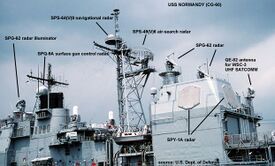SPG-62: Difference between revisions
John Leach (talk | contribs) No edit summary |
John Leach (talk | contribs) m (Text replacement - "[[" to "") |
||
| Line 1: | Line 1: | ||
{{PropDel}}<br><br>{{subpages}} | {{PropDel}}<br><br>{{subpages}} | ||
The ''' | The '''AN-|AN/]]SPG-62''' is a radar#continuous wave|continuous wave]], mechanically steered, radar#Warship combat radars|terminal guidance illumination radar]] for the RIM-156 Standard SM-2]] missile. These missiles use semi-active radar homing]] for their final guidance, so the Mark 99 fire control subsystem of AEGIS time-shares the illumination radars. Other functions of the Mark 99 system include loading, arming and launching the Standard missiles using the vertical launch system]]. | ||
{{Image|Antenna suite on CG-60 Normandy AEGIS cruiser.jpg|left|275px|Three AN/SPG-62 antennas are visible, at far left and second from right}} | {{Image|Antenna suite on CG-60 Normandy AEGIS cruiser.jpg|left|275px|Three AN/SPG-62 antennas are visible, at far left and second from right}} | ||
Primary search and midcourse guidance comes from the | Primary search and midcourse guidance comes from the AN-|AN/]]SPY-1]] phased-array radar, Only as the missile is making final approach to its target does there need to be AN/SPG-62 energy on the target, so the AEGIS battle management system]] can have more missiles flying against more targets than it has illuminators. | ||
Burke-class]] and Kongo-class]] destroyer]]s have three and Ticonderoga-class]] cruiser]]s have four AN/SPG-62's. Spanish ocean escort|F-100 frigate]]s, versions of which are used by Australia, Norway and South Korea, have two. | |||
These radars, made by Raytheon, operate in the | These radars, made by Raytheon, operate in the EU-NATO-US frequency bands|I/J bands]] with a peak power of approximately 10 kilowatts. Obviously, the specific operating frequencies change frequently and are classified, for reasons of electronic warfare#electronic protection|protecting the missile guidance system]] from the target's electronic countermeasures (i.e., its electronic warfare#electronic attack|self-protection electronic attack capabilty]] | ||
Revision as of 16:20, 30 March 2024
| This article may be deleted soon. | ||
|---|---|---|
The AN-|AN/]]SPG-62 is a radar#continuous wave|continuous wave]], mechanically steered, radar#Warship combat radars|terminal guidance illumination radar]] for the RIM-156 Standard SM-2]] missile. These missiles use semi-active radar homing]] for their final guidance, so the Mark 99 fire control subsystem of AEGIS time-shares the illumination radars. Other functions of the Mark 99 system include loading, arming and launching the Standard missiles using the vertical launch system]]. Primary search and midcourse guidance comes from the AN-|AN/]]SPY-1]] phased-array radar, Only as the missile is making final approach to its target does there need to be AN/SPG-62 energy on the target, so the AEGIS battle management system]] can have more missiles flying against more targets than it has illuminators. Burke-class]] and Kongo-class]] destroyer]]s have three and Ticonderoga-class]] cruiser]]s have four AN/SPG-62's. Spanish ocean escort|F-100 frigate]]s, versions of which are used by Australia, Norway and South Korea, have two. These radars, made by Raytheon, operate in the EU-NATO-US frequency bands|I/J bands]] with a peak power of approximately 10 kilowatts. Obviously, the specific operating frequencies change frequently and are classified, for reasons of electronic warfare#electronic protection|protecting the missile guidance system]] from the target's electronic countermeasures (i.e., its electronic warfare#electronic attack|self-protection electronic attack capabilty]] |
||
